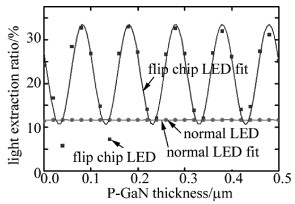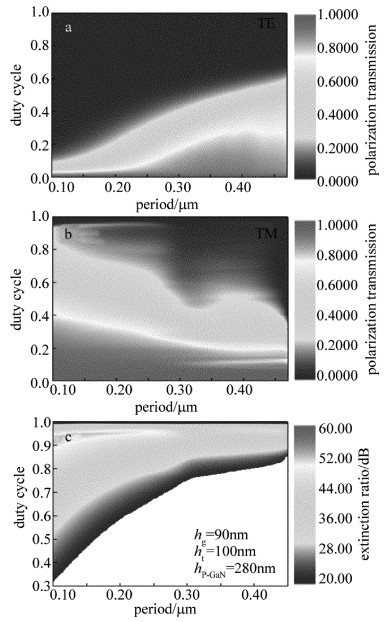HTML
-
发光二极管(light-emitting diode,LED)作为替代白炽灯的下一代光源,由于具有阈值小、寿命长、体积小等特点而被广泛的关注[1],在实际生活中也被应用在各个领域, 如交通信号灯[2]、液晶显示[3]、光互连[4]、磁光存储[5]、可见光通信[6]等。但是在人们的使用过程中发现,LED仍然存在一些影响其应用的问题,其中就有光提取效率低[7]和无法单偏振光输出。导致LED光提取效率低的主要原因是LED材料和周围空气交界处的全反射[8],而无法实现单偏振光输出是因为LED本身没有很强的各向异性。
为了提高LED光提取效率,采用了诸如表面粗化技术[9]、LED倒装技术[10]、光子晶体技术[11]、仿生技术(制作蛾眼形结构)[12]、亚波长光栅技术[13]等。表面粗化技术虽然可以提高光提取效率,但是该技术容易增加GaN层出光面的缺陷,甚至会破坏有源区降低LED的内量子效率;LED倒装技术自2001年被提出后已经商业化,但是倒装LED的光提取效率对P-GaN层厚度非常敏感,P-GaN层厚度微弱的变化都会导致LED光提取效率大幅度的降低或升高;在LED出光面制作类蛾眼结构已经被证实对提高LED光提取效率确实有很多帮助,但是该技术对工艺要求非常高,不利于产业化;光子晶体技术和亚波长技术分别是用光子禁带效应和光栅衍射效应或表面等离子激元来提高LED的光提取效率,但是相对于亚波长光栅技术,光子晶体技术所需成本要高,因此基于生产成本考虑,在提高LED的光提取效率上,使用亚波长光栅技术相对而言是一种更为有效、合理的技术。
实现LED单偏振光输出不仅能够降低液晶显示成本, 而且还能够缩小液晶显示屏体积,在光互联上也能够提高其数据传输效率。但是由于LED本身各向异性很弱,几乎不能实现单偏振光输出,因此需要相关技术帮助LED增强其各向异性。现今已被证实可以增强LED各向异性的技术有:向有源区掺杂Mn元素[14]、在衬底的非极性或半极性面上制作LED器件[15]、利用光子晶体或亚波长光栅引入各向异性[16-17]。第1种存在的问题是要获得高质量单晶材料非常困难,因为Mn和GaN材料在配位上会不匹配;第2种技术虽然能获得单偏振光但是光提取效率会非常的低;第3种技术目前是被大多数学者最为接受的方法。
虽然有很多学者已经就提高LED光提取效率和实现单偏振光输出有了很多的研究,但几乎都是就单独一项的研究,在实现单偏振光输出时没有考虑光提取效率,反之亦然。但在LED实际应用中除了需要有单偏振光输出的同时还需要高的光提取效率,为此本文中基于亚波长光栅技术将Al金属亚波长光栅,二氧化硅(SiO2)介质过渡层与倒装LED相集成,设计出既有高光提取效率还能单偏振光输出的LED。本文中首先比较了倒装LED和普通LED的光提取效率随P-GaN层厚度的关系;随后选取有高提取效率的P-GaN层厚度分析光栅参量对倒装LED的横电波偏振透射率(transverse electro transmission, TET)和横磁波偏振透射率(transverse magnetic transmission, TMT)的影响,并选取既能实现高光提取效率又有高消光比(extinction ratio, ER)的光栅参量;最后分析过渡层厚度对消光比和光提取效率的影响, 从而选择出最优过渡层厚度。最终设计出高光提取效率单偏振光输出的LED。
-
本文中设计的正装蓝光LED中心波长是470nm,结构主要由蓝宝石衬底、N掺杂的GaN层(折射率nN-GaN=2.42,厚度hN-GaN=3000nm)、量子阱有源区(InGaN/GaN)、P掺杂的GaN层(nP-GaN=2.45)和电极构成,如图 1a所示。LED的倒装结构是正装结构的倒立,如图 1b所示。但是图 1b中并没有蓝宝石衬底,这是因为蓝宝石衬底一般有数十微米,其主要作用仅是为了生长GaN层做依托,对光提取效率的影响非常微弱, 因此为了增加模拟计算速度和减小LED体积故将蓝宝石衬底层去掉(但是在实际器件中还是存在蓝宝石衬底)[18]。在倒装LED的结构上集成SiO2介质过渡层和Al金属亚波长光栅后,通过参量设计可以实现单偏振和高的光提取效率,如图 1c所示,h是光栅厚度,s是光栅条宽,p是光栅周期,光栅占空比f=s/p,SiO2介质过渡层厚度为hSiO2。
-
正装LED光提取效率对P-GaN层厚度的变化不敏感,光提取效率几乎恒定不变,但是倒装LED光提取效率对P-GaN层厚度却非常敏感,P-GaN层厚度稍微变化就会引起倒装LED光提取效率大幅的变化,如图 2所示。从图中可以得到正装LED光提取效率在P-GaN层厚度从0nm增加到500nm过程中几乎恒定在11.59%。但是倒装LED光提取效率却以正弦波的形式一直在变化,当P-GaN层厚度在80nm, 180nm, 280nm, 380nm, 480nm时其光提取效率达到最高的32.9%,这相对于正装LED确实有显著的提高,但是当P-GaN层厚度在40nm, 140nm, 240nm, 340nm, 440nm时其光提取效率达到最低的10.5%。所以在一些文献中提到利用倒装技术提高LED的光提取效率虽然可行,但是一定要精确控制P-GaN层厚度。由于倒装LED没有很强的各向异性,TE和TM偏振光透射率均是0.821,根据消光比计算公式可得倒装LED的消光比为0dB,无法实现单偏振光输出。
-
倒装LED通过选择合适的P-GaN层厚度可以提高光提取效率,但是其无法实现单偏振光的输出,为了同时实现倒装LED单偏振光输出,作者在倒装LED上集成了SiO2介质过渡层和Al金属亚波长光栅,如图 1c所示。当P-GaN层厚度hP-GaN=280nm、介质过渡层厚度ht=100nm、光栅厚度hg=90nm时,在光栅占空比从0变化到1,光栅周期p从100nm变化到470nm的范围内,TM(垂直于光栅条方向)偏振透射率要明显大于TE(平行于光栅条方向)偏振的透射率,而且无论是哪种偏振光,均是在低占空比时才有高透射率,最高透射率接近于1,如图 3a和图 3b所示。
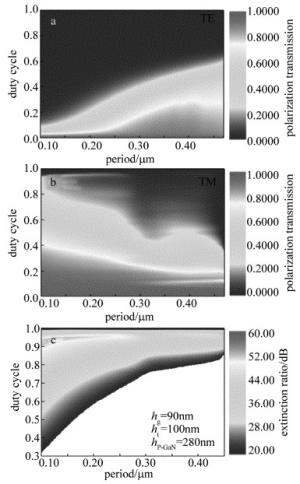
Figure 3. a—TE polarization transmission b—TM polarization transmission c—extinction ratio of TM polarization
根据图 3a和图 3b两偏振光透射率并依据消光比计算公式得出在不同光栅占空比和周期下的TM偏振消光比,如图 3c所示。从图中可以看到,消光比最大可以达到60dB,可是在偏振消光比大的光栅参量下TM的透射率也会比较低。例如在消光比为50dB时,光栅占空比是0.9,周期为150nm,TM透射率仅为0.1,光提取效率在1%附近。如果选择该光栅参量虽然可以得到高消光比的偏振光输出,但是势必是以降低倒装LED光提取效率为代价,故此必须找到既能偏振光输出又能有高光提取效率的光栅参量。通过对比发现, 当光栅占空比为0.4、光栅周期为110nm时,TM偏振透射率不仅可以达到0.8,而且消光比也可以达到22.3dB。
除了光栅占空比和周期对倒装LED偏振光透射率和消光比有影响外,光栅厚度也对其有影响,如图 4所示。此处介质过渡层ht=180nm。随着光栅厚度的增加TE偏振光的透射率会急剧下降最后稳定在0附近,消光比是一直线性升高,但是对于TM偏振光会先小幅升高后小幅下降。在光栅厚度50nm~100nm范围内,TM偏振光的透射率均是在90%以上,可是由于消光比是线性增加,因此在光栅厚度为100nm时消光比最大,消光比为25.8dB。为了有高的透射率能保持高光提取效率,同时实现稳定单偏振光输出,可以将光栅厚度设为100nm。
-
TM偏振光透射率和消光比随着过渡介质层厚度ht的变化会有先增加后减小的循环变化趋势,但是TE偏振光透射率几乎稳定在0附近,如图 5所示。ht从0nm增加到220nm过程中,TM偏振光透射率虽然在波动变化,但其值均在0.75以上,其中只有ht在160nm~180nm范围内,TM偏振光透射率是在0.9以上。因为TM偏振光透射率的波动变化也导致消光比在波动变化,但其值均在23dB以上。为了能够保持高TM透射率实现高光提取效率,同时为了有稳定的偏振光输出,可将ht设置为180nm,当ht=180nm时,TM偏振光透射率为0.902,消光比也达到25.8dB。
2.1. P-GaN层厚度对倒装和正装LED光提取效率的影响
2.2. 光栅参量对倒装LED偏振光透射率和消光比的影响
2.3. 过渡介质层厚度对倒装LED偏振光透射率和消光比的影响
-
根据第2节可知,优化后既可以实现高光提取效率又可以实现稳定单偏振光输出的光栅参量和光栅介质层厚度是:f=0.4, p=110nm, hg=100nm, ht=180nm。从图 5可知, 在优化后的光栅参量下偏振光的消光比可以达到25.8dB,根据一些研究可知, 消光比在20dB以上时就可以保证稳定的偏振光输出[19]。
相比于没有集成光栅的倒装LED,集成了金属光栅后的倒装LED其光提取效率明显的提高,并且其光提取效率并不会因为P-GaN层厚度hP-GaN微小变化会有剧烈的变化,反而是一直稳定在一个值,如图 6所示。没有集成亚波长光栅时,随着hP-GaN变化,光提取效率最高为32.9%,最低为10.5%,变化非常剧烈,但是当集成光栅后,除了在hP-GaN < 80nm时光提取效率有大幅度变化,当hP-GaN>80nm后,光提取效率均稳定在57.63%。故此经过结构优化后, 集成光栅的倒装LED以25.8dB的消光比和57.63%的光提取效率实现高光提取效率单偏振光输出。
-
利用RSOFT软件建立正装、倒装和集成金属光栅倒装LED结构,研究了P-GaN层厚度hP-GaN对正装和倒装LED光提取效率的影响,得出倒装LED确实能提高光提取效率,但是光提取效率对hP-GaN极为敏感。为了同时实现单偏振光输出和高光提取效率,优化了集成金属亚波长光栅倒装LED结构,得出当f=0.4, p=110nm, hg=100nm, ht=180nm时不仅可以实现57.63%的高光提取效率,同时还可以使偏振光消光比达到25.8dB,而且集成有金属亚波长光栅的倒装LED的光提取效率不会因hP-GaN变化会有剧烈的波动,当hP-GaN>80nm时, 均维持在57.63%,这降低了工艺精度要求。

 Map
Map


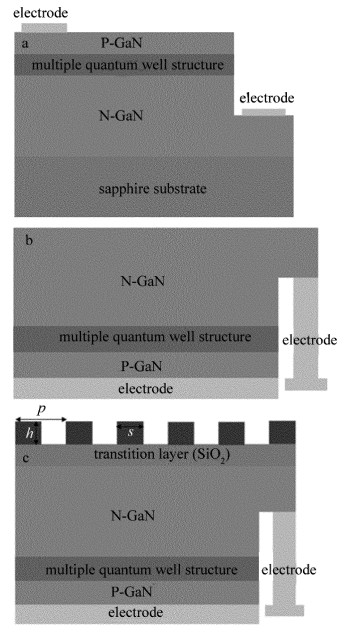


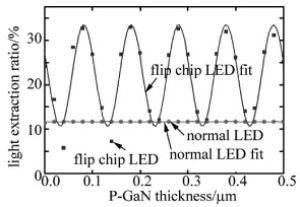

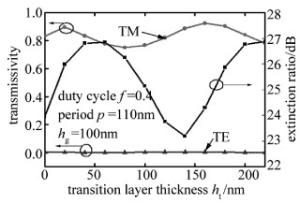
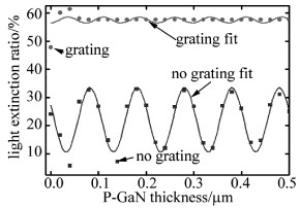
 DownLoad:
DownLoad:
